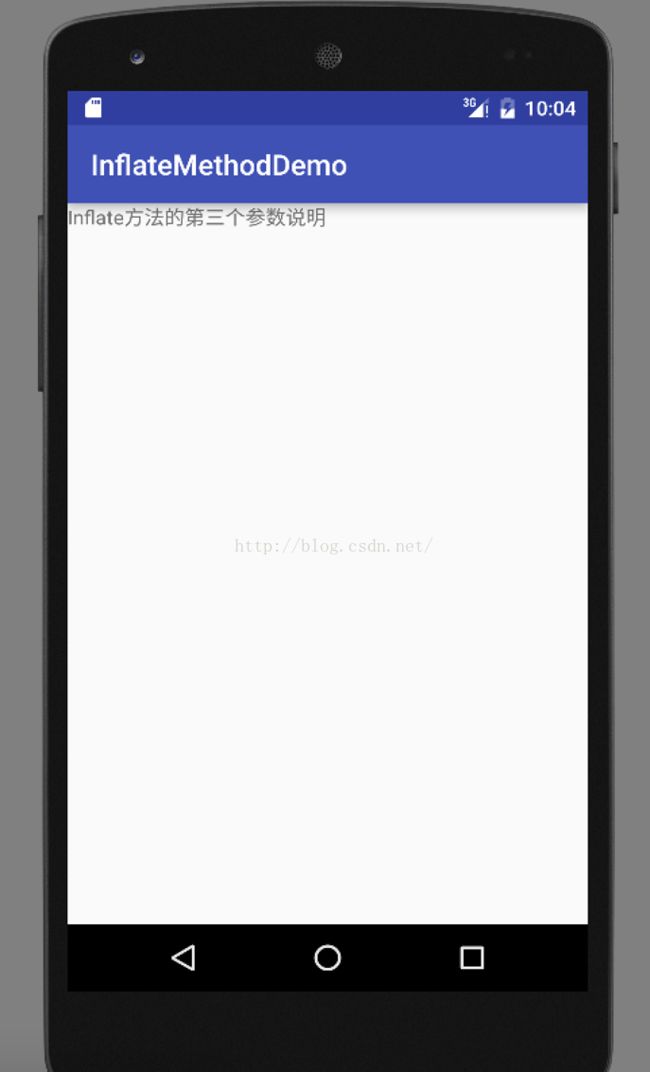Android中LayoutInflater类的inflate方法的使用及注意事项
我们在讲一个定义好的布局文件(xml)文件加载到界面上展现出来的时候,通常会用到LayoutInflater的inflate方法,细心的同学会发现这个方法有四种重载,分别是:
public View inflate(@LayoutRes int resource, @Nullable ViewGroup root);public View inflate(XmlPullParser parser, @Nullable ViewGroup root);public View inflate(@LayoutRes int resource, @Nullable ViewGroup root, boolean attachToRoot);public View inflate(XmlPullParser parser, @Nullable ViewGroup root, boolean attachToRoot);/**
* Inflate a new view hierarchy from the specified xml resource. Throws
* {@link InflateException} if there is an error.
*
* @param resource ID for an XML layout resource to load (e.g.,
* R.layout.main_page)
* @param root Optional view to be the parent of the generated hierarchy.
* @return The root View of the inflated hierarchy. If root was supplied,
* this is the root View; otherwise it is the root of the inflated
* XML file.
*/
public View inflate(@LayoutRes int resource, @Nullable ViewGroup root) {
return inflate(resource, root, root != null);
}
/**
* Inflate a new view hierarchy from the specified xml node. Throws
* {@link InflateException} if there is an error. *
*
* Important For performance
* reasons, view inflation relies heavily on pre-processing of XML files
* that is done at build time. Therefore, it is not currently possible to
* use LayoutInflater with an XmlPullParser over a plain XML file at runtime.
*
* @param parser XML dom node containing the description of the view
* hierarchy.
* @param root Optional view to be the parent of the generated hierarchy.
* @return The root View of the inflated hierarchy. If root was supplied,
* this is the root View; otherwise it is the root of the inflated
* XML file.
*/
public View inflate(XmlPullParser parser, @Nullable ViewGroup root) {
return inflate(parser, root, root != null);
}
/**
* Inflate a new view hierarchy from the specified xml resource. Throws
* {@link InflateException} if there is an error.
*
* @param resource ID for an XML layout resource to load (e.g.,
* R.layout.main_page)
* @param root Optional view to be the parent of the generated hierarchy (if
* attachToRoot is true), or else simply an object that
* provides a set of LayoutParams values for root of the returned
* hierarchy (if attachToRoot is false.)
* @param attachToRoot Whether the inflated hierarchy should be attached to
* the root parameter? If false, root is only used to create the
* correct subclass of LayoutParams for the root view in the XML.
* @return The root View of the inflated hierarchy. If root was supplied and
* attachToRoot is true, this is root; otherwise it is the root of
* the inflated XML file.
*/
public View inflate(@LayoutRes int resource, @Nullable ViewGroup root, boolean attachToRoot) {
final Resources res = getContext().getResources();
if (DEBUG) {
Log.d(TAG, "INFLATING from resource: \"" + res.getResourceName(resource) + "\" ("
+ Integer.toHexString(resource) + ")");
}
final XmlResourceParser parser = res.getLayout(resource);
try {
return inflate(parser, root, attachToRoot);
} finally {
parser.close();
}
}
/**
* Inflate a new view hierarchy from the specified XML node. Throws
* {@link InflateException} if there is an error.
*
* Important For performance
* reasons, view inflation relies heavily on pre-processing of XML files
* that is done at build time. Therefore, it is not currently possible to
* use LayoutInflater with an XmlPullParser over a plain XML file at runtime.
*
* @param parser XML dom node containing the description of the view
* hierarchy.
* @param root Optional view to be the parent of the generated hierarchy (if
* attachToRoot is true), or else simply an object that
* provides a set of LayoutParams values for root of the returned
* hierarchy (if attachToRoot is false.)
* @param attachToRoot Whether the inflated hierarchy should be attached to
* the root parameter? If false, root is only used to create the
* correct subclass of LayoutParams for the root view in the XML.
* @return The root View of the inflated hierarchy. If root was supplied and
* attachToRoot is true, this is root; otherwise it is the root of
* the inflated XML file.
*/
public View inflate(XmlPullParser parser, @Nullable ViewGroup root, boolean attachToRoot) {
synchronized (mConstructorArgs) {
Trace.traceBegin(Trace.TRACE_TAG_VIEW, "inflate");
final Context inflaterContext = mContext;
final AttributeSet attrs = Xml.asAttributeSet(parser);
Context lastContext = (Context) mConstructorArgs[0];
mConstructorArgs[0] = inflaterContext;
View result = root;
try {
// Look for the root node.
int type;
while ((type = parser.next()) != XmlPullParser.START_TAG &&
type != XmlPullParser.END_DOCUMENT) {
// Empty
}
if (type != XmlPullParser.START_TAG) {
throw new InflateException(parser.getPositionDescription()
+ ": No start tag found!");
}
final String name = parser.getName();
if (DEBUG) {
System.out.println("**************************");
System.out.println("Creating root view: "
+ name);
System.out.println("**************************");
}
if (TAG_MERGE.equals(name)) {
if (root == null || !attachToRoot) {
throw new InflateException("
根据以上源码我们会发现,重载的四个方法归根结底最后调用的都是这个方法:
public View inflate(XmlPullParser parser, @Nullable ViewGroup root, boolean attachToRoot)该方法和以下方法的区别在于下面的方法根据提供的resource来获得相应的parser,然后再调用上面的方法。
public View inflate(@LayoutRes int resource, @Nullable ViewGroup root, boolean attachToRoot)所以我们主要来分析这个方法。参数详解:
第一个参数:int resource,表示需要加载布局文件的id,意思是需要将这个布局文件中加载到Activity中来操作;
第二个参数:ViewGroup root,表示需要附加到resource资源文件的根控件。说明:调用inflate方法后会得到一个View对象,root参数就是接收该 View对象的容器;
第三个参数:boolean attachToRoot, 表示是否把inflate得到的View对象添加到root中,该参数为false时,表示不直接添加到root中;该参数为true时,表示直接添加到root中;
下面同过具体代码来说明:
activity_main.xml
inflate_view_layout.xml
package com.rainmonth.inflatemethoddemo;
import android.support.v7.app.AppCompatActivity;
import android.os.Bundle;
import android.text.Layout;
import android.view.LayoutInflater;
import android.view.View;
import android.widget.FrameLayout;
public class MainActivity extends AppCompatActivity {
@Override
protected void onCreate(Bundle savedInstanceState) {
super.onCreate(savedInstanceState);
setContentView(R.layout.activity_main);
FrameLayout frameLayout = (FrameLayout) findViewById(R.id.fl_container);
// 第三个参数设置为false
View inflateView = LayoutInflater.from(this).inflate(R.layout.inflate_view_layout, frameLayout, false);
// 第三个参数设置为true,默认为true
// View inflateView = LayoutInflater.from(this).inflate(R.layout.inflate_view_layout, frameLayout, true);
}
}
第三个参数为false时的运行结果如下:
此时,inflateView 对应的布局内容并未呈现出来。
第三个参数为true时的运行结果如下:
此时inflateView对应的布局内容呈现出来了。由此可见第三个参数的作用就是是否把inflate出来的参数加入到root容器中,false时不添加;true时添加。
为了验证结论,我们在第三个参数为false时在添加一下代码:
frameLayout.addView(inflateView);
